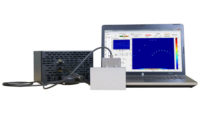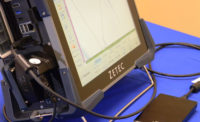NDT - Phased Array
Parallel Phased Arrays to Achieve High-Speed Inspection
Automation and parallel phased array systems are being used to meet challenging inspection and production requirements.

Figure 1. This shows an industrial implementation of a testing portal for automated phased array inspection of heavy walled seamless tubes. Source: Karl Deutsch

Figure 2. Here is a close-up view of the probe holders, electronics and water-delivery system for the automated tube inspection shown in Figure 1. The phased-array controllers that drive the probes are labeled “A” and “B” and are visible at the top of the picture. Source: Karl Deutsch

Figure 3. Weld inspection configuration using two arrays (“L”) for longitudinal defect detection and one array (“W”) to measure wall thickness and detect delaminations. Source: Karl Deutsch

Figure 4. Simulation results illustrate the time delays (red bars) applied to subsets of elements on curved phased arrays to perform angled-beam inspections designed to detect internal and near-surface defects. Source: Karl Deutsch

Figure 5. Test results (C-scans and amplitude strip charts) for angled-beam inspections performed on ERW pipe. Source: Karl Deutsch





One of the greatest challenges in industrial nondestructive testing (NDT) is performing inspections at high production rates. Ultrasonic phased arrays are successfully being used to achieve high-speed inspection through utilization of multiple probes and inspection systems operated in parallel. Another advantage of phased array inspection is the ability to perform multiple inspections with the same probe, for example, electronic beam steering allows a range of angled-beam inspections to be performed with the same probe. The ability to perform electronic scanning with phased arrays can also significantly increase inspection rates compared to mechanical translation of the probes. The examples presented below demonstrate how automation and parallel phased array systems are being used to meet the challenging inspection and production requirements encountered in high-speed tube and pipe manufacturing.
Inspection Strategy
Testing systems are typically unique and optimized for each application depending on the type of tube/pipe, the manufacturing process and the end use [1]. Pipe mills present a challenging industrial environment, and often operate with three shifts to achieve production capacities of 90% or more. Inspection systems must therefore be fast and extremely robust, able to operate trouble free in an environment with many sources of electromagnetic interference.
Because air is a poor conductor of ultrasound, a couplant between the probes and test specimens is usually required. Water is most often used as the couplant in industrial implementations, and coupling solutions for automated inspection include immersion tanks; water-gap coupling in which a small water gap on the order of 0.5 mm between probe and part is maintained by probe guides such as rollers that traverse along the pipe; and water jets (squirters), which provide laminar flow between the probe and part for water paths that are typically between 30 and 50 mm. Care must be taken to ensure that the water path covers the entire ultrasonic beam and that the flow path is free of bubbles and turbulence.
An accurate and fast calibration procedure is also essential for maintaining rate and ensuring accurate results. A calibration unit that includes a short section of pipe with calibrated defects is often included with tube and pipe inspection systems.
Heavy-Wall Seamless Tubes
Figures 1 and 2 show photographs of an automated inspection system developed for heavy-walled seamless tubes. The system can handle tubes with diameters between 178 and 419 mm, wall thicknesses between 20 and 100 mm, and lengths between 4 and 15 m [2]. Multiple linear phased array probes are used in parallel to reach the desired throughput.
Five 2-MHz linear arrays are grouped in housings and used in parallel to detect longitudinal defects. In this case, optimizing the beam angle for the tube is essential, and the use of phased arrays makes it possible to adjust the angle as necessary for varying diameters and thicknesses without having to change the probes. Similarly, two 4-MHz linear arrays are housed together and used in parallel to detect transverse defects. In this case, electronic scanning across the probes is utilized and the ultrasonic beams from individual shots are designed to overlap to ensure coverage and reduce amplitude variability.
Four of the five probe holders visible in Figure 2 house the arrays used for the longitudinal and transverse inspections. The fifth holds an array that is used to measure wall thickness and to detect delaminations. In this case, the probe is a 4-MHz linear array. Normal-incident beams are used to measure the wall thickness, and the resulting data are displayed as a C-scan image for the entire tube wall. For high-resolution imaging of delaminations, focusing is applied in transmission and reception.
The phased array probe holders are gimbal mounted to the testing carriage which travels along the test portal. Hardened-steel rollers act as probe guides. With the tube rotating, the probes are moved down the longitudinal axis of the tube, resulting in helical inspection paths. A water-jet (squirter) system is used to provide water coupling between the probes and tube. The water delivery system is designed to provide a constant flow without bubbles or turbulence. An advantage of the squirter system over contact measurements is that the probes are not subjected to wear.
The inspection strategy is designed to provide very high throughput, 100% coverage, and high-resolution detection and imaging of defects. To drive the large number of probes in parallel and perform multiple inspections with the same probes requires sophisticated phased-array electronics.
Online Inspection of ERW Pipe
Electric-Resistance-Welded (ERW) pipe is manufactured by forming continuous strips and welding the longitudinal seam. The manufacturing process usually includes removing burrs and weld flash from the outside and/or inside weld surface. Ultrasonic inspection is typically used at several points in the production process to ensure the quality of the pipe and weld [3]. This article focuses on the online weld test. The inspection time matches the welding speed, which is typically 15 to 25 m/s. Although some inspections such as the pipe-end test may be performed manually, requirements for welded pipes almost always require automated inspection. Inspecting as early as possible after each manufacturing operation is advantageous in providing immediate process feedback.
The position of the circumferential weld sometimes wanders over the pipe length which creates a probe positioning challenge. For the inspection described here, a tracking system is used to accurately position the probes with respect to the weld. Because there is no weld crown to use for tracking, a pilot line is painted onto the pipe at the time of welding. A CCD camera tracks the line and a programmable-logic controller centers the probes with respect to the weld with a positioning accuracy of approximately ±2 mm.
The inspection requirements include the ability to perform circumferential angled-beam measurements at several angles to detect flaws, as well as a normal-incidence inspection, which provides a thickness measurement and a check of the deburring operation. Tandem measurements in the weld area to detect lack of fusion are also required. With phased arrays, pseudo-tandem measurements are made using a single probe by transmitting from elements at one end of the array and receiving on elements at the opposite end.
For the online inspection system described here, the range in pipe diameter is 140 to 340 mm. To minimize cost, time and inspection complexity, it is highly desirable to inspect the full range of diameters with the same set of phased array probes. Curved arrays were chosen instead of flat probes to minimize the required steering angles and to increase the test sensitivity. A total of three phased array probes are used (see Figure 3) compared to five conventional single-element probes used for a similar inspection that does not utilize arrays.
The probe design and inspection strategy were determined with the aid of CIVA simulation software, which makes it possible to ensure circumferential coverage and optimize the beam-forming strategies. The ultrasonic beams are formed by firing subsets of the array elements (also called virtual probes). The inspection is challenging because of the large number of measurements that have to be made at high speed and the need to perform multiple inspections with the same probe. The number of parameters that have to be optimized for each individual inspection include the number of active elements and the beam-forming strategy used for each shot, as well as the shot index (distance between sequential shots). The simulation results displayed in Figure 4 illustrate the time delays (red bars) applied to subsets of elements on the curved arrays to perform angled-beam inspections.
To account for differences between the curvature of the arrays and the pipe surfaces, each virtual probe employs different delay laws. To apply the delays at the speed required mandates a powerful phased array unit and controlling software. In this case, the inspection was optimized by finding the best compromises for the total pulse-repetition frequency, testing modes (angled-beam and tandem-probe inspections), coupling control, and the step indices for the longitudinal and circumferential pipe axes.
Three parallel phased array systems with a combined total of 320 channels are used to perform the measurements. The large number of channels is essential in this case to achieve the required inspection rate and shot index, to provide the flexibility required for the computation and application of the delay laws for the multiple inspections, and to allow parallel firing of several virtual arrays within a single probe. The systems also allow customized displays. For this application, real-time scans (A-scans, B-scans and C-scans) are displayed for the inspections performed in parallel, as well as a strip-chart representation of the ultrasonic amplitudes versus pipe length, which is commonly provided by conventional inspection systems (see Figure 5).
Although the probes and controlling electronics are more expensive, the use of phased arrays for the online inspection of ERW pipe provides several benefits compared to performing the same inspection with conventional single-element probes:
- The mechanics required for probe handling are reduced because of the reduction in the number of probes from five to three.
- It is possible to perform multiple angled-beam inspections and tandem measurements with the same probe.
- Because the relatively large probes result in a wide inspection zone, the variability in the weld-seam position is less critical, reducing the challenge of tracking the weld.
- The use of arrays allows visualization of inspection results (e.g., C-scans and cross-sectional views).
- Full coverage of the weld scarfing area is obtained using a straight-beam array, which provides improved process feedback compared to a single-element oscillating probe.
References
-
Wolfram A. K. Deutsch, Peter Schulte, Michael Joswig and Rainer Kattwinkel, “Automated Ultrasonic Pipe Weld Inspection,” in Proc. WCNDT, Shanghai, China, October 25-28, 2008.
-
Wolfram A. K. Deutsch, Michael Joswig, Klaus Maxam, Stefan Nitsche, Michel Vahe, Alexandre Noël, Patrick Pichard and Sylvain Deutsch, “Phased Array Ultrasonic Testing of Heavy-Wall Seamless Tubes by Means of a Testing Portal,” in Proc. ECNDT, Moscow, Russia, June 7-11, 2010.
- Wolfram A. K. Deutsch, Mathias Razeng, Werner Roye, Klaus Maxam and Peter Schulte, “Phased Array UT or Conventional UT: A Reference Analysis Based on Industrial Installations for Welded Tubes,” presented at ASNT Fall Conference, Orlando, FL, October 29-31, 2012.
Looking for a reprint of this article?
From high-res PDFs to custom plaques, order your copy today!










